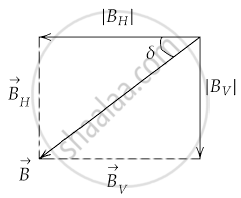Advertisements
Advertisements
प्रश्न
Assume the dipole model for earth’s magnetic field B which is given by BV = vertical component of magnetic field = `mu_0/(4pi) (2m cos theta)/r^3` BH = Horizontal component of magnetic field = `mu_0/(4pi) (sin theta m)/r^3` θ = 90° – lattitude as measured from magnetic equator. Find loci of points for which (i) |B| is minimum; (ii) dip angle is zero and (iii) dip angle is ± 45°.
उत्तर
(i) We know from the figure.

`B^2 + B_V^2 + B_H^2`
= `[mu_0/(4pi) (2m cos theta)/r^3]^2 + [mu_0/(4pi) (m sin theta)/r^3]^2`
Substituting the value of BV and BH from question
= `[mu_0/(4pi)]^2 m^2/r^3 [4cos^2 theta + sin^2 theta]`
`B^2 = (mu_0/(4pi)) xx m^2/r^3 [3 cos^2 theta + 1]`
`B = mu_0/(4pi) m/r^3 [3 cos^2 theta + 1]^(1/2)` ......(i)
From equation (i), the value of B will be minimum when `[3cos^2 theta + 1]^(1/2)` is minimum which will be at `theta= pi/2`. So magnetic equator lies ar `theta = pi/2`, i.e., from magnetic dipole axis `theta = pi/2` for magnetic equator.
(ii) For angle of dip δ
tan δ = `B_r/B_H = (mu_0/(4pi) (2m cos theta)/r^3)/(mu_0/(4pi) (m sin theta)/r^3)`
tan δ = 2 cot θ
For δ = 0, cot θ = 0, θ = `pi/2`
So angle of dip will lie at magnetic equator.
(iii) tan δ = `B_V/B_H` = angle of dip δ = ± 45°
⇒ `B_V/B_H` = tan ± 45°
⇒ `B_V/B_H` = tan 45°
`B_V/B_H` = 1 or BV = BH
δ = ± 45°
tan ± 45° = 2 cos θ .....[∵ tan δ = 2 cot θ]
cot θ = `1/2` or tan θ = 2
θ = tan–12 is the locus of points where the angle of dip δ = ± 45°.
APPEARS IN
संबंधित प्रश्न
Choose the correct option.
The horizontal and vertical component of magnetic field of Earth are same at someplace on the surface of Earth. The magnetic dip angle at this place will be
What happens to the angle of dip as we move towards magnetic pole from magnetic equator?
Answer the following question regarding earth’s magnetism:
The earth’s field, it is claimed, roughly approximates the field due to a dipole of magnetic moment 8 × 1022 J T−1 located at its centre. Check the order of magnitude of this number in some way.
The earth’s magnetic field varies from point to point in space. Does it also change with time? If so, on what time scale does it change appreciably?
At a given place on earth’s surface the horizontal component of earth’s magnetic field is 2 × 103-5 T and resultant magnetic field is 4 × 103-5 T. The angle of dip at this place is ______.
A satellite S is moving in an elliptical orbit around the earth. The mass of the satellite is very small compared to the mass of the earth. Then,
The vertical component of earth's magnetic field is zero at a place where angle of dip is
At a place of latitude 5°, angle of dip is nearly
Isogonic lines are those for which ______.
